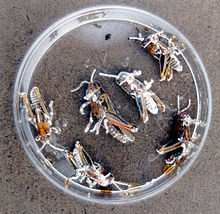
Back بوفيريا باسيانا Arabic Beauveria bassiana Byelorussian Beauveria bassiana Catalan Beauveria bassiana CEB Beauveria bassiana Czech Beauveria bassiana Spanish Beauveria bassiana Estonian Beauveria bassiana French Beauveria bassiana Galician Beauveria bassiana ID
| Beauveria bassiana | |
|---|---|

| |
| Grasshoppers killed by B. bassiana | |
| Scientific classification | |
| Domain: | Eukaryota |
| Kingdom: | Fungi |
| Division: | Ascomycota |
| Class: | Sordariomycetes |
| Order: | Hypocreales |
| Family: | Cordycipitaceae |
| Genus: | Beauveria |
| Species: | B. bassiana
|
| Binomial name | |
| Beauveria bassiana (Bals.-Criv.) Vuill. (1912)
| |
| Synonyms | |
| |
Beauveria bassiana is a fungus that grows naturally in soils throughout the world and acts as a parasite on various arthropod species, causing white muscardine disease; it thus belongs to the group of entomopathogenic fungi. It is used as a biological insecticide to control a number of pests, including termites, thrips, whiteflies, aphids and various beetles. Its use in the control of bed bugs[1] and malaria-transmitting mosquitos is under investigation.[2]
- ^ Barbarin, Alexis M.; Jenkins, Nina E.; Rajotte, Edwin G.; Thomas, Matthew B. (15 September 2012). "A preliminary evaluation of the potential of Beauveria bassiana for bed bug control" (PDF). Journal of Invertebrate Pathology. 111 (1): 82–85. doi:10.1016/j.jip.2012.04.009. PMID 22555012. Archived from the original (PDF) on 14 July 2020. Retrieved 21 November 2012.
- ^ Donald G. McNeil Jr., Fungus Fatal to Mosquito May Aid Global War on Malaria, The New York Times, 10 June 2005
© MMXXIII Rich X Search. We shall prevail. All rights reserved. Rich X Search